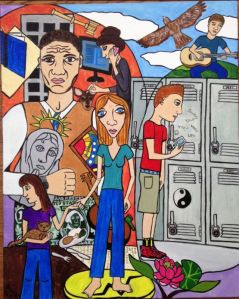Everyone pays a visit to the Heartbreak Hotel at some point, so I thought the place was worth a painting. The Heartbreak Hotel is one of many stops on life’s highway, though I wouldn’t recommend it as a final destination.
I used the five stages of grief first posited by Elisabeth Kubler-Ross (denial, anger, bargaining, depression, acceptance) in her 1969 book, On Death and Dying, as a stepping-off point for painting the characters in this piece, and then added a few ‘stages’ of my own. I’ll leave it to you to figure out which stage is embodied by which figure. In the 40-plus years since her book was published, Kubler-Ross’ theory of a continuum of grief along which people progress in a relatively linear fashion has been pretty soundly debunked, however, the stages themselves are still relevant as forms of human suffering and the various ways we come to terms with, fight against, or succumb to a great loss in our lives.
This piece is similar stylistically and thematically to other paintings in my autobiographical series. Stylistically I continue to use bright colors and cartoon-like figures and to break the frame up into smaller sections in a non-linear narrative. Thematically I create a visual depiction of a psychological state, or states, of mind.
By the way, I’m thrilled to announce that the Untitled painting in my last post, also part of this series, won third place in the painting category at the City of Normandy Park’s Annual Arts Festival the first weekend in June.

